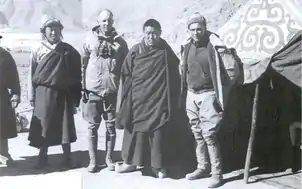Brooke Dolan II
Brooke Dolan II (1908 – Chongqing, China, August 19 or 29, 1945) was an American adventurer and naturalist in the 1930s and 1940s.[1][2][3] His father was Brooke Dolan, a wealthy American industrialist in Philadelphia. During World War II, he served as a lieutenant and captain.[4][5]
.png.webp)

Overview
Brooke Dolan II was born October 12, 1908,[6] and educated at Princeton University and Harvard University.[1][4][7][8] He was a trustee of the Academy of Natural Sciences in Philadelphia. He led two expeditions to China and eastern Tibet in 1931 to 1932 and 1934 to 1936.[4][8][9] The first expedition comprised Ernst Schäfer, a German zoologist, Gordon Bowles, Otto Gneiser, and Hugo Weigold.[4][9] The second comprised Schäfer[4][8][9] and Marion Duncan, an American missionary. Dolan's second expedition may have been motivated partly by the need to take a leave of absence from Philadelphia society after a January 1934 arrest on disorderly conduct charges.[4]
On April 15, 1934, Dolan married Emilie Campan Gerhard, daughter of Albert Pepper Gerhard, of Overbrook, Philadelphia[7] who accompanied him for a while on his second trip to China.[4]
Dolan joined the United States Army Air Forces after the attack on Pearl Harbor.[1][4] In 1942 he traveled to Lhasa with Ilia Tolstoy, a grandson of Leo Tolstoy, as a member of the Office of Strategic Services (OSS), to meet with the Tibetan government. On December 20, 1942, they met the young 14th Dalai Lama and his Regent, the 3rd Taktra Rinpoche.[5][8][10] They were the first Americans ever to meet a Dalai Lama.[5] Tolstoy and Dolan, who were nicknamed "Mud" and "Slug" by their fellow OSS officers, both received the Legion of Merit for the mission.[10][11] They are considered to have gone beyond their authority in leading the Tibetan government to believe the United States had given international political recognition to Tibet. Photographs taken by Dolan and Tolstoy on their expedition were published in A Portrait of Lost Tibet by Rosemary Jones Tung.[12]
After the Tibetan expedition Dolan transferred from the OSS to the Army Air Forces and joined the United States Military Observer Group in Yunnan, China.[1][13] Dolan died in Chongqing, China. According to some accounts, he was killed on an OSS mission to rescue downed Allied bomber crews;[1] according to other accounts, he took his own life on August 19, 1945.[3]
References
- Beolens, Bo; Watkins, Michael (2003). Whose Bird? Common Bird Names and the People They Commemorate. New Haven, London: Yale University Press. p. 108. ISBN 0-300-10359-X. LCCN 2003113608.
- The Anglers' Club Story, Our First Fifty Years, 1906-1956. The Anglers' Club of New York. 1956. p. 47.
- Meyer, Karl E.; Brysac, Shareen Blair (2006). Tournament of Shadows: The Great Game and the Race for Empire in Central Asia. New York: Basic Books. p. 550. ISBN 978-0-465-04576-1.
- Meyer & Brysac 2006, pp. 534–536
- Starks, Richard (2012). Lost in Tibet: The Untold Story of Five American Airmen, a Doomed Plane, and the Will to Survive. Rowman & Littlefield. pp. 90–92. ISBN 978-0-7627-8931-3.
- https://historyhub.history.gov/cfs-file/__key/communityserver-discussions-components-files/59/40479_5F00_649063_5F00_0434_2D00_02224.jpg
- Carter, Thomas T. (May 11, 1934). "Tibetan Explorer Trapped". Princeton Alumni Weekly. XXXIV (31): 716.
- Coleman, Katie. "PhilaPlace - Academy of Natural Sciences: From Science to War – Brooke Dolan II of The Academy of Natural Sciences". Historical Society of Pennsylvania. Retrieved July 29, 2017.
- Troelstra, A.S. (2016). Bibliography of Natural History Travel Narratives. Brill Publishers. p. 375. ISBN 9789004343788.
- Moon, Tom (2000). This Grim and Savage Game: OSS and the Beginning of U.S. Covert Operations in World War II. Da Capo Press. pp. 76–79. ISBN 0-306-80956-7.
- Meyer & Brysac 2006, p. 546
- New York: Holt, Rinehart, and Winston, 1980; London: Thames and Hudson, 1980; Ithaca, N.Y.: Snow Lion Publications, 1987, c1980; Berkeley: University of California Press, 1996, c1980
- Meyer & Brysac 2006, p. 548
Sources
- Meyer, Karl Ernest; Brysac, Shareen Blair (2006) [1999]. Tournament of Shadows: The Great Game and the Race for Empire in Central Asia. Basic Books. pp. 531–49 & 552–53. ISBN 978-0-465-04576-1.
- Dolan, Brooke, II, Road to the Edge of the World, Frontiers; October 1936, pp. 5–9
- Dolan, Brooke, II, Road to the Edge of the World, Proceedings of the Academy of Natural Sciences (Philadelphia), 1937
- Duncan, Marion, The Yangtze and the Yak, Alexandria VA, 1952
- Hale, Christopher, Himmler’s Crusade, Hoboken NJ: Wiley & Sons, 2003
- Knaus, John Kenneth, Orphans of the Cold War: America and the Tibetan Struggle for Survival, Chapter 1, New York: Public Affairs, 1999